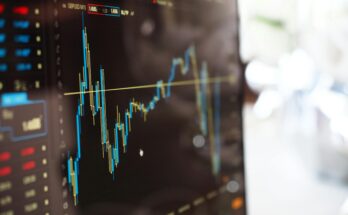Introduction
The investment landscape in 2025 is set to be shaped by a range of innovative trends, technologies, and evolving market conditions. As global economies recover and adapt to new challenges, investors must stay informed about the top financial trends that will impact their investment strategies. This article explores the key trends in investing for 2025, including sustainable investing, digital assets, decentralized finance (DeFi), and artificial intelligence. By understanding these trends, investors can position themselves for success in an ever-changing market.
1. Rise of Digital Assets: Cryptocurrency and Beyond
Digital assets, including cryptocurrencies, non-fungible tokens (NFTs), and blockchain-based financial products, are increasingly becoming a significant part of the investment landscape. In 2025, the role of digital assets is expected to expand, with new use cases emerging in traditional and decentralized finance.
Cryptocurrency Adoption and Regulation:
- Mainstream Acceptance: Cryptocurrencies like Bitcoin, Ethereum, and newer digital assets are becoming more accepted by businesses, consumers, and financial institutions. With the increased interest in digital currencies, there is growing confidence in their long-term viability as part of a diversified investment portfolio.
- Regulation and Compliance: As digital assets continue to gain traction, regulators around the world are establishing frameworks to ensure their security and compliance. In 2025, we will see more clarity on the legal status of cryptocurrencies and stricter regulations for crypto exchanges, helping to protect investors and reduce fraud.
- Central Bank Digital Currencies (CBDCs): Governments are exploring the creation of their own digital currencies. These state-backed cryptocurrencies, known as CBDCs, may revolutionize the global financial system and offer investors a new form of digital asset to consider in their portfolios.
Non-Fungible Tokens (NFTs):
- Investment in Art and Collectibles: NFTs have gained attention for their ability to tokenize unique assets, such as digital art, music, and collectibles. In 2025, we expect the NFT market to mature, with more established artists, brands, and investors participating in the space.
- Real Estate and Virtual Assets: NFTs are also being used to represent ownership of physical assets like real estate, as well as virtual assets within metaverse environments. This opens up new opportunities for investors to explore alternative asset classes.
2. Decentralized Finance (DeFi): A New Era in Financial Services
Decentralized finance (DeFi) is an emerging sector that seeks to transform traditional financial services by creating peer-to-peer alternatives to banking, lending, trading, and insurance. By using blockchain technology, DeFi platforms offer greater transparency, lower fees, and more accessible financial services.
DeFi Lending and Borrowing:
- Decentralized Lending Platforms: Platforms like Aave and Compound allow users to lend and borrow cryptocurrencies without intermediaries. This creates opportunities for higher interest rates on savings and more flexible loan options for borrowers.
- Yield farming: Yield farming, a popular DeFi practice, involves providing liquidity to DeFi platforms in exchange for rewards. As more users participate in yield farming, it is expected to become a mainstream investment strategy in 2025.
DeFi Insurance and Risk Management:
- Smart Contract Insurance: DeFi insurance protocols leverage smart contracts to provide coverage for a wide range of risks, from flight delays to natural disasters. These decentralized insurance products could provide lower premiums and faster payouts than traditional insurance companies.
- Risk Pools: DeFi platforms allow users to create decentralized risk pools, where members contribute funds to share risk. This peer-to-peer model could challenge traditional insurance companies in the future.
3. Sustainable Investing: Focus on ESG Factors
Environmental, Social, and Governance (ESG) investing continues to grow in popularity as investors seek to align their financial portfolios with their values. In 2025, sustainable investing will become more mainstream as governments, corporations, and investors push for more responsible and transparent financial practices.
Green bonds and impact funds:
- Green bonds: Green bonds are issued by companies or governments to finance environmentally sustainable projects such as renewable energy and energy-efficient infrastructure. With the increased focus on climate change in 2025, green bonds are expected to become a major component of global investment portfolios.
- Impact Investing: Impact investing focuses on businesses and projects that generate measurable social and environmental benefits alongside financial returns. Investors are increasingly seeking out impact funds that target sectors like clean energy, sustainable agriculture, and affordable housing.
Climate Change and Carbon Neutral Investing:
- Carbon Markets: Carbon markets are growing as companies look for ways to offset their carbon emissions. Carbon credits, which allow companies to invest in sustainability projects that reduce emissions, will become a key asset class in 2025.
- Net-Zero Portfolios: Many institutional investors are moving towards net-zero portfolios, which align their investments with the global goal of reducing carbon emissions. This trend will likely accelerate as the world pushes to meet climate targets.
4. AI and Machine Learning in Investment Decisions
Artificial intelligence (AI) and machine learning (ML) are revolutionizing the investment process. In 2025, these technologies will become even more integrated into investment strategies, providing investors with new tools for analysis, decision-making, and portfolio management.
AI-Powered Investment Platforms:
- Robo-Advisors: Robo-advisors use AI algorithms to recommend investment strategies based on individual risk profiles and financial goals. In 2025, these platforms will become more sophisticated, incorporating machine learning to adapt and optimize investment strategies in real-time.
- Sentiment Analysis: AI can analyze news, social media, and financial reports to gauge market sentiment. By processing vast amounts of data, AI can identify trends and potential market movements, allowing investors to make informed decisions faster than traditional methods.
Automated Trading and High-Frequency Trading (HFT):
- AI in Trading: AI is being used to develop algorithmic trading strategies that can process market data and execute trades in milliseconds. In 2025, these AI-driven platforms will continue to dominate the high-frequency trading space.
- Predictive Analytics: AI can predict stock price movements, volatility, and market trends by analyzing historical data and patterns. Investors can use these insights to make more informed decisions and maximize their returns.
5. Global Market Diversification: Embracing Emerging Markets
As investors look for higher returns, many are turning to emerging markets for investment opportunities. These regions, including Asia, Africa, and Latin America, are expected to see significant economic growth in 2025, making them attractive targets for international investors.
Investing in Emerging Markets:
- Asia’s Economic Growth: Asia, particularly China and India, will remain key players in the global economy. Investors will continue to look for opportunities in technology, healthcare, and renewable energy sectors in these fast-growing markets.
- Africa and Latin America: These regions are experiencing growing populations, urbanization, and infrastructure development. As a result, they present significant potential for long-term investments, particularly in sectors such as renewable energy, agriculture, and financial services.
Global Real Estate Investment:
- Cross-Border Real Estate Investment: With global interest rates expected to remain low, international real estate investment will continue to rise in 2025. Investors will look to diversify their portfolios by purchasing property in emerging markets with high growth potential.
Conclusion
The investment landscape in 2025 is shaped by new technologies, shifting market dynamics, and a growing emphasis on sustainability. From the rise of digital assets like cryptocurrency to the increasing role of AI in decision-making, investors must stay ahead of these trends to optimize their portfolios. Additionally, sustainable investing and the growth of emerging markets offer new opportunities for those looking to align their investments with global trends. By understanding and leveraging these top financial trends, investors can position themselves for success in a rapidly evolving market.



